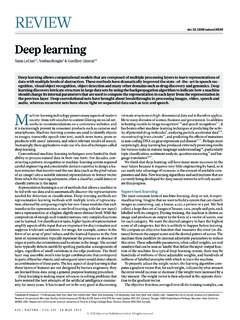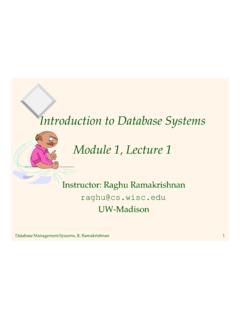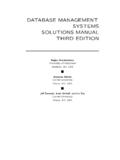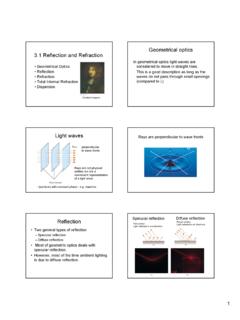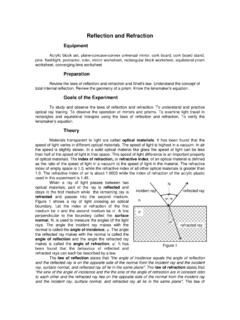Transcription of Specular Reflection: i = r
1 Chapter 1- page 1 You need to learn the concepts and formulae highlighted in red. The rest of the text is for your intellectual enjoyment, but is not a requirement for homework or exams. Chapter 1 REFLECTION and refraction Specular REFLECTION OF light 1. Imagine a mirror surface, which is perfectly flat, polished and reflecting. Now imagine a line, perpendicular to the mirror surface, called the normal. The normal forms angles of 90 degrees from the mirror surface. When light illuminates a mirror such as this, it is reflected. In the diagram below, a ray of light coming from the left is incident (or incoming ) on the mirror surface.
2 The angle marked i is called the angle of incidence, and it is measured from the normal (in this particular diagram, i = 45 ). The incident ray is reflected by the mirror into another ray: the reflected ray of light with an angle of reflection r, again, measured from the normal. The angle of incidence and the angle of reflection are equal, or i = r. This is the law of Specular reflection, from the Latin word speculum , meaning mirror. The law of Specular reflection is valid for any value of the angle of incidence i, not only for the 45 angle reported in the diagram.
3 This law is all you really need to know about Specular reflection. All polished and smooth surfaces reflect light as a mirror. Usually mirrors are a combination of a glass pane, which can be made very flat and smooth, coated on its back by a reflective metal layer. All materials, even the most insulating and transparent ones, such as uncoated glass, reflect light , at least to some extent. To see this you can do a simple experiment. Take a transparent pane of glass and standing in front of it in a dark room. Even though the pane is transparent, there is no source of light behind the pane, therefore there is no light i = angle of incidencer = angle of reflectionSpecular Reflection: i = rnormalir Chapter 1- page 2 for the pane to transmit towards your eye.
4 If you now place a source of light , for instance a lit candle between you and the pane, you can easily see the small glass reflectivity. light from the candle travels in all directions. The rays that from the candle go toward the pane are reflected back, and your eye can see the reflection of the candle. Of course, since the glass is transparent, most of the light from the candle goes through the glass and you don t see it, but a small proportion of that light is reflected back towards you. Since the room is dark, you can see the small amount of light forming the reflected virtual image. The same phenomenon is constantly visible in everyday life.
5 When you are standing outside in daylight and look at a building all windows reflect the outside world, including the sky, other buildings and trees? This happens because the window panes are very flat and slightly reflecting, and there is more light outside than inside the building, so they reflect the outside world exactly as the candle was reflected in the previous example. The same happens at night, although in the opposite direction. When there is artificial illumination inside, and it is dark outside, people from outside can see in, through the window panes very well, while from inside at night, you can t see outside, and you only see the reflection of yourself and the rest of the room.
6 If you want to see outside, you must turn the light off inside. The general rule is, therefore, that you can see from darker to brighter, through a window pane, but not vice versa, because of reflection. Conversely, you only see reflection if you stand on the bright side. Another observation is that the reflectivity of polished surfaces is greater at grazing incidence, that is, when the angle of incidence (and the one of reflection) are close to 90 . Most objects around us are not perfectly polished, and are not good Specular reflectors. When they are illuminated they do not reflect light according to the law of reflection.
7 Non-polished objects diffusely reflect (or scatter) light in all directions around them. This means that you do not have to be in a specific position, at a specific angle to see an illuminated object. You can be at any angle from it, and still see it. This is quite convenient! Every non-polished, illuminated object can be considered as a source of light rays. Obviously, not many objects emit light , as do the sun, incandescent light bulbs, neon lights, fluorescent lights, or computer monitors. Nevertheless, when illuminated by a specific source of light , non-polished objects diffusely reflect light in all directions.
8 From the geometric point of view, they can be schematically represented as the center of diverging rays, sources of light rays. Chapter 1- page 3 2. Imagine an object in front of a mirror. The diverging rays of light that originate from the object, marked O in the diagram below, are reflected by the mirror. The reflected rays of light behave as if they originated from a point I. The point I is called the virtual image of the object O. To find the image position of any object, draw the normal to the mirror and measure the object distance from the mirror. The image I is located at the same distance as the object from the mirror, but on the opposite side.
9 This is why it is called a virtual image. In other words, there are no real rays of light that diverge from the point I. In the above drawing, it is only the artificial extensions of the rays (dashed lines) that originate from I. Any ray from O that strikes the mirror is reflected, so that it seems to come from I. If you now remove the mirror, and place the point object O at the point I, it will look identical to the reflected point O. The eye cannot tell the difference between rays coming from a virtual image I and a real object at the same position. When you look at yourself in the mirror, what you see is a virtual image of yourself, and that virtual image is behind the mirror.
10 If a friend of yours looks behind the mirror, there will be no image of you behind the mirror. Another important observation is that vertically mounted mirrors invert left and right, but not top and bottom. Horizontally mounted mirrors only invert top and bottom, but not left and right. The image is virtual, not realO = object I = image reflected rays seem to come from I Point I is located behind the mirror at a distance h equal to the distance between O and the mirror Point O and point I are on a line perpendicular to the plane of the mirrorIO90 hh Chapter 1- page 4 3. Why is gold yellow? Why are silver and aluminum gray?
